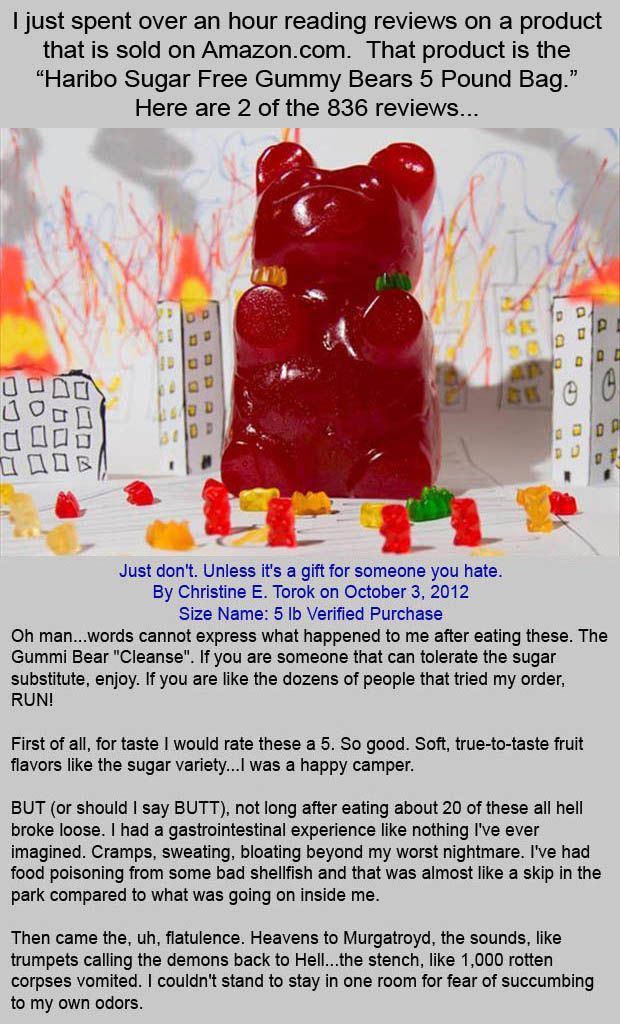In the vast universe of consumer products, gummy bears are among the most beloved. These chewy, colorful treats often evoke nostalgia and joy. However, one variety, Haribo Sugar-Free Gummy Bears, has gained notoriety not just for its taste, but for the wildly entertaining and often alarming reviews left by unsuspecting customers on Amazon. This article delves into the comical world of sugary delights gone wrong, exploring the humorous facets of gummy bears, consumer reactions, and the underlying health implications.

funny amazon reviews gummy bears
Understanding the Gummy Bear Phenomenon
Gummy bears are universally recognized as a fun candy option. According to celebrity chefs and nutritionists alike, they offer a delightful experience, but moderation is key. Renowned celebrity chef Gordon Ramsay once quipped, “Food is about balance, and that includes sugary sweets.” This balance seems particularly crucial when addressing the sugar-free versions, which often contain sugar substitutes such as maltitol and sorbitol—ingredients that can lead to gastrointestinal distress.
The Comedy Goldmine of Sugar-Free Gummy Bear Reviews
It is safe to say that the reviews of Haribo’s sugar-free gummy bears have cultivated a comedic goldmine. One particular review starts with, “See you in hell,” implying an unexpected and humorous descent into digestive turmoil. These reviews have sparked a trend where consumers warn others, showcasing their personal experiences with phrases like “the Gummy Bear Cleanse,” which humorously indicates that these treats can induce severe intestinal reactions for many. This phenomenon encapsulates a form of shared humor that resonates on multiple levels—both as a warning and a comedic story.
The Health Aspects of Gummy Bears: Sweet, but at What Cost?
While gummy bears are clearly not health food, there is an ongoing debate about their nutritional value. Registered dietitian Alyssa Dweck emphasizes, “Gummy bears can provide a quick energy boost due to their sugar content, but sugar-free versions can disturb your gut health due to sugar alcohols.” In essence, while traditional gummy bears satisfy a sweet craving, the sugar-free variants pose a risk for those unaccustomed to sugar substitutes. Alongside the humor, there lies an essential public health conversation about ingredient transparency and consumer awareness.
Nutritional Analysis of Sugar-Free Gummy Bears
Curious about what you’re really consuming? Let’s break down the nutritional profile. Haribo Sugar-Free Gummy Bears primarily contain maltitol, which yields approximately 50% fewer calories than sugar. For those counting calories, this can seem like a positive alternative. However, the gastrointestinal side effects—often described in vivid detail in customer reviews—demonstrate that “healthier” doesn’t always mean safer or more pleasant. Many users have humorously reported needing numerous bathroom trips following their consumption, dubbing it the “St. Diarrhea’s Day Massacre.”
Emotional Impact: Laughter and Shared Experiences
The shared experiences found in Amazon reviews generate a unique camaraderie among readers. Humor serves as a coping mechanism, as consumer Chris P. noted, “I laughed so hard, I almost forgot the pain.” Such reactions create a sense of community, allowing individuals to bond over shared misfortunes. In a world replete with stressful news cycles, these light-hearted narratives provide a refreshing escape.
Celebrity Comments on Gummy Bear Culture
As the gummy bear trend permeates mainstream media, celebrities have even chimed in on the subject. Fun-loving comedian Ellen DeGeneres joked in her show, “Do I prefer regret or a tummy ache? That’s a dilemma only sugar-free gummy bears can provide!” Such comments only boost the visibility of these humorous reviews, bridging the gap between casual consumers and pop culture. They emphasize that while these gummy treats may not be the healthiest option, they certainly provide unrivaled entertainment.
Creating Balance: Enjoying Gummy Bears Healthily
The key takeaway surrounding gummy bears, particularly the sugar-free varieties, is balance. Recognizing when to indulge and when to segregate treats from a healthy diet is pivotal. As nutritionist and author Dr. Mark Hyman once said, “Food should be a source of joy, not a source of shame.” Consumers can enjoy gummy bears while being mindful of portion sizes and ingredient awareness, allowing for a balanced approach to sweets.
Continuing the Dialogue Around Sweet Treats
As consumers embark on their journey to knowledge regarding sugar alternatives and health, discussions are vital. Blogs, podcasts, and community forums are emerging as platforms for ongoing dialogue. It’s essential to communicate honestly about experiences, like those humorous yet cautionary tales from Amazon. They invoke laughter but also invoke the seriousness of understanding what we consume.
Conclusion: Laughing Through the Sweetness
In conclusion, the wild and humorous reviews of Haribo Sugar-Free Gummy Bears do more than entertain; they open a window to discussions about health, humor, and community. These candid tales transform a simple candy product into a cultural phenomenon. Although such gummy bears are often a gamble for your stomach, they prove to be an unrivaled source of laughter and reflection.
Frequently Asked Questions (FAQs)
Which company has the best gummies?
Many enthusiasts believe Haribo remains a top contender, alongside brands like Jelly Belly and Albanese for their unique textures and flavors.
Is there anything healthy about gummy bears?
While they contain gelatin, which has benefits for skin and hair, the sugars and additives in gummy bears can outweigh these benefits if consumed excessively.
What’s in sugar-free Haribo gummy bears?
The main ingredient is maltitol, a sugar alcohol that can have digestive effects, particularly in larger quantities.
How many calories are in sugar-free gummy bears?
Typically, sugar-free gummy bears contain about 70 calories per serving, but this can vary based on the brand.